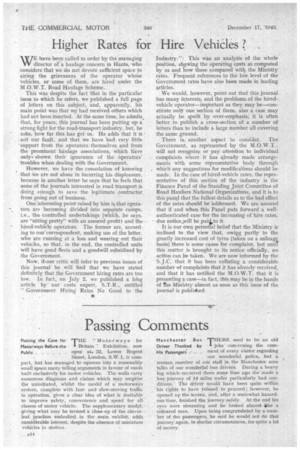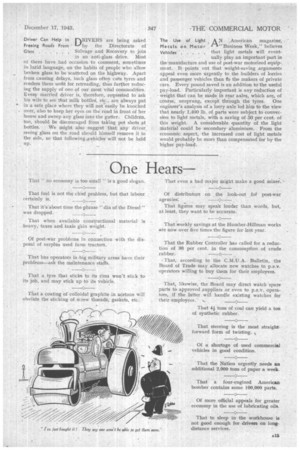Passing Comments Putting the Case for T' "Motorways for Motorways
Page 16

Page 17

If you've noticed an error in this article please click here to report it so we can fix it.
Before the Britain" Exhibition, now Public open at 22, 'Lower Regent Street, London, S.W.1, is compact, but has managed to squeeze into a reasonably small space many telling arguments in favour of roads built exclusively for motor vehicles. The walls carry numerous diagrams and claim S which may surprise the uninitiated, whilst the model of amotorways system, complete with fastand slow-moving traffic in operation, gives a clear idea of what is desirable to improve safety, convenience and speed for alL classes of motor vehicle.. The supplementary model, • giving what may be termed a close-up of the cloverleaf junction embodied . in the main exhibit, adds considerable interest,despite the absence of miniature vehicles in itotion. THERE used to be an old I joke' used
the com
ment of every visitor regarding our wonderful police, but a woman member of °Ur staff in the Manchester area talks of our wonderful. bus drivers. During a heavy fog which' occurred :there some time ago. she' made a bus" journey of 14 miles under particularly bad con' ditionS. The driver would have been quite within his rights to have refused to proceed ; however, he opened up the screen, and, after a soniewhat hazardous time, finished the journey safely. At the end his • eyes were streaming and he looked almost joke a . .coloured man. Upon being congratulated by a num' her of the passengers, he said he would not do that journey again, in similarecircumstances, for quite a lot of money,
His Passengers' .
nRIVERS are being asked
by the Directorate of Salvage and Recovery to join in an anti-glass drive. Most of them have. had occasion to comment, sometimes in lurid language, on the habits of people who allow broken glass to be scattered on the highway. Apart from causing delays, §uch glass often cuts tyres and renders them unfit for retreading, thus further reducing the supply of one of our most vital commodities. Ever.y married driver is, therefore, requested to ask his wife to see that milk bottles, etc., are always put in a safe place where they will noeeasily be knocked over, also to keep her eyes on the road in front of her house and sweep any glass into the gutter. Children, too, should be discouraged from taking pot shots at
bottles. We might also suggest that any driver seeing glass on the road should himself remove it to the side, so that following _vehicles will not be held up,
Driver Can Help in Freeing Road's From ' Glass .
The Use of Light A N American magazine; Metals on Motor 1-k "Business Week," believes
Veh icles that light metals will event ually play an important part in the'mantifacture and use of post-war motorized equipment. It points out that weight-saving arguments appeal even more urgently to the builders of lorries and passenger vehicles than to the makers of private cars. Every pound saved is an addition to the useful pay-load. Particularly important is any reduction of weight that can be made in rear axles, which are, of course, unsprung, except through the tyres. One engineer's analysis of a lorry axle led him to the view that nearly 1,400 lb. of parts were subject to conversion to light metals, with a saving of 50 per cent. of this weight. A considerable quantity of the light material' could be secondary aluminium. From the economic aspect, the increased cost of light metals would probably be more than compensated for by the higher pay-load.




















































